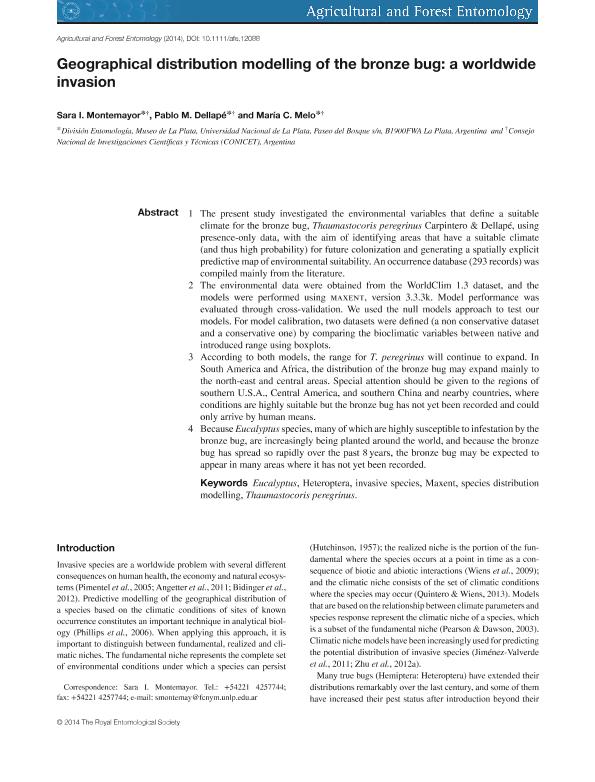Mostrar el registro sencillo del ítem
dc.contributor.author
Montemayor Borsinger, Sara Itzel

dc.contributor.author
Dellapé, Pablo Matías

dc.contributor.author
Melo, María Cecilia

dc.date.available
2018-01-10T19:01:06Z
dc.date.issued
2014-10
dc.identifier.citation
Dellapé, Pablo Matías; Melo, María Cecilia; Montemayor Borsinger, Sara Itzel; Geographical distribution modelling of the bronze bug: a worldwide invasion; Wiley Blackwell Publishing, Inc; Agricultural And Forest Entomology; 17; 2; 10-2014; 129-137
dc.identifier.issn
1461-9555
dc.identifier.uri
http://hdl.handle.net/11336/32870
dc.description.abstract
1 The present study investigated the environmental variables that define a suitableclimate for the bronze bug,Thaumastocoris peregrinusCarpintero & Dellapé, usingpresence-only data, with the aim of identifying areas that have a suitable climate(and thus high probability) for future colonization and generating a spatially explicitpredictive map of environmental suitability. An occurrence database (293 records) wascompiled mainly from the literature.2 The environmental data were obtained from the WorldClim 1.3 dataset, and themodels were performed using maxent, version 3.3.3k. Model performance wasevaluated through cross-validation. We used the null models approach to test ourmodels. For model calibration, two datasets were defined (a non conservative datasetand a conservative one) by comparing the bioclimatic variables between native andintroduced range using boxplots.3 According to both models, the range forT. peregrinuswill continue to expand. InSouth America and Africa, the distribution of the bronze bug may expand mainly tothe north-east and central areas. Special attention should be given to the regions ofsouthern U.S.A., Central America, and southern China and nearby countries, whereconditions are highly suitable but the bronze bug has not yet been recorded and couldonly arrive by human means.4 BecauseEucalyptusspecies, many of which are highly susceptible to infestation by thebronze bug, are increasingly being planted around the world, and because the bronzebug has spread so rapidly over the past 8 years, the bronze bug may be expected toappear in many areas where it has not yet been recorded.
dc.format
application/pdf
dc.language.iso
eng
dc.publisher
Wiley Blackwell Publishing, Inc

dc.rights
info:eu-repo/semantics/openAccess
dc.rights.uri
https://creativecommons.org/licenses/by-nc-sa/2.5/ar/
dc.subject
Eucalyptus
dc.subject
Heteroptera
dc.subject
Invasive Species
dc.subject
Maxent
dc.subject
Species Distribution Modelling
dc.subject
Thaumastocoris Peregrinus
dc.subject.classification
Otras Ciencias Biológicas

dc.subject.classification
Ciencias Biológicas

dc.subject.classification
CIENCIAS NATURALES Y EXACTAS

dc.title
Geographical distribution modelling of the bronze bug: a worldwide invasion
dc.type
info:eu-repo/semantics/article
dc.type
info:ar-repo/semantics/artículo
dc.type
info:eu-repo/semantics/publishedVersion
dc.date.updated
2018-01-10T16:53:50Z
dc.journal.volume
17
dc.journal.number
2
dc.journal.pagination
129-137
dc.journal.pais
Reino Unido

dc.journal.ciudad
Londres
dc.description.fil
Fil: Montemayor Borsinger, Sara Itzel. Consejo Nacional de Investigaciones Científicas y Técnicas; Argentina. Universidad Nacional de La Plata. Facultad de Ciencias Naturales y Museo. División Entomología; Argentina
dc.description.fil
Fil: Dellapé, Pablo Matías. Consejo Nacional de Investigaciones Científicas y Técnicas; Argentina. Universidad Nacional de La Plata. Facultad de Ciencias Naturales y Museo. División Entomología; Argentina
dc.description.fil
Fil: Melo, María Cecilia. Consejo Nacional de Investigaciones Científicas y Técnicas; Argentina. Universidad Nacional de La Plata. Facultad de Ciencias Naturales y Museo. División Entomología; Argentina
dc.journal.title
Agricultural And Forest Entomology

dc.relation.alternativeid
info:eu-repo/semantics/altIdentifier/doi/http://dx.doi.org/10.1111/afe.12088
dc.relation.alternativeid
info:eu-repo/semantics/altIdentifier/url/http://onlinelibrary.wiley.com/doi/10.1111/afe.12088/abstract
Archivos asociados
